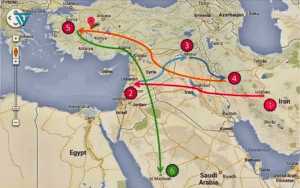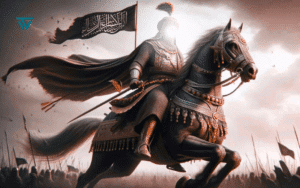Prophet Muhammad (ﷺ): The Last Messenger of Islam

Before Prophet Muhammad (ﷺ) arrived, history shows the world experienced terrible turmoil. The Arabian Peninsula was particularly affected. In that era, Arab society largely lacked justice and humanity. Unrest and immorality dominated instead. People felt confused. Misguidance, superstition, and widespread idolatry also corrupted religious practices. Social inequality was rampant. Furthermore, people of all genders and social classes faced extreme degradation. Families buried baby girls alive shortly after birth. Daily entertainment often centered on alcohol. Society frequently treated women as mere commodities. The powerful oppressed the weak, leaving them helpless. Blood feuds often caused extended conflicts between communities. Slavery was widespread. Cheating, usury, adultery, and murder occurred frequently. During this period of extreme decline, Allah Almighty sent Prophet Muhammad (ﷺ). He was the greatest human being and a light of guidance. Allah sent him to achieve humanity’s salvation.
Allah, the Lord of the Worlds, declared:
وَمَا أَرْسَلْنَاكَ إِلَّا رَحْمَةً لِّلْعَالَمِينَ
“And We have not sent you, [O Muhammad], except as a mercy to the worlds.”
(Surah Al-Anbiya: 107)
The Great Prophet’s Birth and Childhood
Prophet Muhammad (ﷺ) was born in Mecca’s holy city. This is in present-day Saudi Arabia. He belonged to the Banu Hashim group within the Quraysh community. This was an honorable and respected lineage. Throughout Arab society, people knew this clan for honesty, high ideals, and hospitality. The Messenger of Allah Prophet Muhammad (ﷺ) arrived in this world at dawn. This occurred on Monday, the 12th of Rabi’ al-Awwal, in 570 CE. Arab society calls this day “Amul Fil” (the Year of the Elephant). In that same year, Abraha, Yemen’s king, marched with elephants. He intended to destroy the Kaaba. However, Allah miraculously thwarted his aggression. Abdullah was the Prophet’s father. Amina was his mother.
His father passed away before his birth. His mother Amina cared for him. She also died when he was only six. Following this, his grandfather, Abdul Muttalib, became his guardian. Sadly, his grandfather also passed away just two years later. At eight years old, the orphaned Muhammad (ﷺ) came under his affectionate uncle Abu Talib’s care. Abu Talib loved him like his own child. His childhood involved poverty, orphanhood, and harsh realities. This experience served as a unique training ground. It slowly prepared him to become the great Messenger.
Prophet Muhammad (ﷺ) Fosterage Period
Initially, Prophet Muhammad’s (ﷺ) mother, Amina, nursed him. Afterward, Thuwayba, Abu Lahab’s slave, had the honor. She briefly breastfed him. Later, Arab custom dictated seeking a suitable wet nurse for a newborn. This practice allowed the child to grow up in a pure, rural environment. During this time, the noble Halima Sadia received this great blessing. She was from the Banu Sa’d branch of the Hawazin community.. As it happened, no other wet nurse agreed to take baby Muhammad (ﷺ). Halima herself had not found any other child. Consequently, out of necessity, she accepted Prophet Muhammad (ﷺ). This was part of Allah’s preordained plan. Immediately after taking him, Halima noticed blessings in her life.
Scarcity had previously marked her existence. Her dry camel filled with milk. Her sickly donkey gained speed. Peace returned to her entire family. Halima’s love and affection nurtured Prophet Muhammad (ﷺ) until he was two. Then, Halima returned him to his mother Amina in Mecca. She requested permission to keep the child under her care longer. An epidemic had spread in Mecca, so Amina consented. Thus, the Prophet stayed with Halima’s family until he was five. During these years, he grew up in a rural setting with his foster siblings. He lived a simple life herding goats. This activity built a strong foundation for his future leadership.
Adolescence and the Title of Al-Amin
Prophet Muhammad’s (ﷺ) adolescence was responsible and honorable. From a young age, all Makkans recognized his honesty and fairness. They knew his trustworthiness. Due to his excellent character, people called him “Al-Amin.” This name means “the trustworthy” and “the truthful.” This title acknowledged his honesty. It was one of his life’s greatest honors. From childhood, he was honest, hardworking, and faithful. He was truthful in every word, never wronged anyone, and always fulfilled his duties with unwavering diligence.
These qualities afforded him a special status in Makkan society. Even high-ranking individuals respected him. His honesty and fair business conduct particularly earned him the ‘Al-Amin’ title.
Prophet Muhammad (ﷺ) Marriage to Khadijah (RA)
At twenty-five, Prophet Muhammad (ﷺ) married Khadijah bint Khuwaylid. She was a wealthy woman from Mecca. Khadijah (RA) was a noble, chaste, and successful businesswoman. She managed trade caravans and took a share of the profits. Mecca widely knew Prophet Muhammad’s (ﷺ) honesty, truthfulness, and trustworthiness. People renowned him as ‘Al-Amin’ and ‘As-Sakin.’ So, Khadijah (RA) entrusted her business to him. Muhammad (ﷺ) conducted business very profitably. He presented every account clearly and accurately to Khadijah. Khadijah (RA) heard about the Messenger’s (ﷺ) qualities. She also learned of the miraculous signs accompanying him. So, she proposed marriage to him. With mutual consent, they completed their marriage. At that time, Khadijah was about 40 years old.
As long as Khadijah (RA) lived, the Messenger (ﷺ) felt no need for another marriage. Later, the Prophet (ﷺ) married a total of eleven wives. These marriages helped expand Islam. They also met various social and ideological needs. Two of these wives passed away before him. He lived a marital life with the remaining nine.
Prophet Muhammad (ﷺ) Purposes and Reasons for Subsequent Marriages
Later in his life, Prophet Muhammad (ﷺ) married eleven wives. These marriages served deep social, ideological, and educational purposes. They went beyond mere personal or family formation.
- Establishing Social Cohesion: A primary aim of the Prophet’s marriages was building relationships. He sought to unite different communities and families. These unions especially helped establish friendship. They fostered unity with different communities within Muslim society.
- Protecting Women: At that time, ensuring social security for women was necessary. Society needed to protect the dignity of widows and divorced women. The Prophet’s (ﷺ) marriages offered protection. They provided honor to many widows and vulnerable women.
- Propagating Islamic Ideals: The Prophet’s wives were among Islam’s first students. They were also the earliest believing women in history. Through them, Islamic laws and women’s rights spread. Moral education and ideals also spread throughout society. Thus, the Prophet’s marriages became a field for education. They helped establish ideals.
- Setting Educational Examples: The Prophet’s family life set an example. It showed women’s dignity, mutual respect, harmony, and empathy. These marriages served as a living lesson. They helped determine women’s place and responsibilities in society.
Beginning of Revelation
The Great Prophet Muhammad (ﷺ) often spent time in the Cave of Hira. This cave is near Mecca’s famous ‘Jabal-e-Noor’ mountain. He regularly stayed there for several nights. He made all necessary arrangements beforehand. His solitude and worship further strengthened his heart. One day, he visited the Cave of Hira. A sacred moment arrived in his life. He attained prophethood. The Great Prophet was then 41 years old. This occurred on the 27th of Rajab, 13 years before the Hijra. This corresponds to 610 CE. While awake and conscious, the angel Jibrail (عليه السلام), Prophet Muhammad (ﷺ), appeared. This was the angel’s first appearance to him. Jibrail (عليه السلام) delivered Allah’s final divine message. This message was for the world’s people. He also delivered the first verses of ‘Al-Quranul Karim.’ This is humanity’s guide to salvation. From this moment, the Great Prophet (ﷺ) undertook a tremendous responsibility.
He was to guide the world towards light.
Then the Angel Jibrail (عليه السلام) began reciting the noble words:
اقْرَأْ بِاسْمِ رَبِّكَ الَّذِي خَلَقَ (1) خَلَقَ الْإِنسَانَ مِنْ عَلَقٍ (2) اقْرَأْ وَرَبُّكَ الْأَكْرَمُ (3) الَّذِي عَلَّمَ بِالْقَلَمِ (4) عَلَّمَ الْإِنسَانَ مَا لَمْ يَعْلَمْ (5)
“Recite in the name of your Lord who created— (1) Created man from a clinging substance. (2) Recite, and your Lord is the Most Generous— (3) Who taught by the pen— (4) Taught man that which he knew not.” (5)
(Surah Al-Alaq: 1-5)
The Great Prophet (ﷺ) initially responded, “Can I read?” But at the angel’s command, he started receiving the message. This event marked a new awakening for humanity. It was also Allah’s divine declaration. Later, this message transformed lives for all humankind. It created a path of light in everyone’s hearts.
Mi’raj (Ascension)
The Messenger of Allah (ﷺ) was 51 years and nine months old. Then, Allah honored him with an extraordinary distinction. This demonstrated His infinite mercy and grace. The magnificent journey of Isra and Mi’raj is a key event in Islamic history. The journey began from Mecca’s Kaaba Sharif. From there, he traveled physically by night (Isra). He went to Bayt al-Maqdis (Jerusalem). His mount for this journey was Buraq. Buraq was a swift, white animal. It resembled a horse with bird-like legs. Buraq carried him safely and quickly from the Kaaba to Bayt al-Maqdis. Afterward, he ascended through the seven heavens. This was part of the Mi’raj. He reached Allah’s Great Arsh (Throne). At this time, Allah Almighty specifically honored him. Allah showed him the supremely sacred realm.
This realm was enveloped in divine light. During this Mi’raj journey, the Messenger (ﷺ) met with Allah. He received the obligation of the five daily prayers. These prayers became a foundational pillar of the Muslim community. Additionally, during the Mi’raj, he witnessed astonishing scenes. He saw Paradise (Jannah) and Hell (Jahannam). These scenes served as tangible reflections of Allah’s rewards and punishments. This grand Mi’raj journey remains a source of faith for Muslims. It serves as a source of spiritual elevation, a testament to the immense honor Allah bestowed upon His Prophet, and a reflection of the divine glory granted to him. This unique event in the Prophet’s life plays a special role. It helps establish Islam’s greatness and truth.
The Command to Preach (Da’wah)
After a silent period following the revelation, Allah Almighty commanded His Prophet. Prophet Muhammad (ﷺ) was to invite humanity to the religion. Allah entrusted the heavy responsibility of prophethood to him. Allah designated him as a guide for Mecca and all humankind. This grave responsibility commenced with a clear Quranic command from Allah Almighty:
يَا أَيُّهَا الْمُدَّثِّرُ (1) قُمْ فَأَنذِرْ (2) وَرَبَّكَ فَكَبِّرْ (3) “
O you who wraps himself [in clothing], (1) Arise and warn, (2) And your Lord glorify.” (3)
(Surah Al-Muddaththir, verses 1-3)
These verses directly ordered the Prophet to start spreading the religion. “Muddaththir” means “the one who wraps himself [in clothing].” It referred to the specific state when he was resting. He was wrapped in a cloak. Jibrail (عليه السلام) then came again. The angel instructed him to fulfill prophethood’s momentous duty. Through these verses, Allah Almighty made it clear. The Prophet had no more time for rest. Calling all humanity to truth’s path was his primary task. These verses began the chapter of officially preaching Islam.
Secret Preaching of Islam
Before Allah’s open proclamation, Prophet Muhammad (ﷺ) invited people to Islam secretly. He did this with great caution and wisdom initially. During this period, he first conveyed Tawhid’s message (Oneness of God). He shared it with his close ones. He did not force anyone to accept Islam. Instead, he invited them with love, logic, and compassion. He wanted to reveal Islam’s beauty and truth. His beloved wife, Khadijah (R.A), was first to embrace Islam. She was the Mother of Believers. Afterward, others accepted Islam one by one.
- Among men: Abu Bakr as-Siddiq (R.A).
- Among adolescents: Ali ibn Abi Talib (R.A).
- Among slaves: Zayd ibn Harithah (R.A).
After Abu Bakr (RA) embraced Islam, he invited many others. These were virtuous and respected companions. They joined the fold of Islam. Examples include Usman ibn Affan (R.A) and Abdur Rahman ibn Awf. Talha ibn Ubaydullah and Sa’d ibn Abi Waqqas (R.A) also accepted. This secret preaching period lasted about three years. During this time, the Prophet’s invitation focused on certain people. These were reliable, trustworthy, and sincerely truth-seeking individuals in Mecca. The number of Muslims was small then. However, their faith was strong. Throughout this period, Muslims gathered at ‘Darul Arqam.’ This house was adjacent to the Kaaba. There, they learned about Islam and performed worship. This time of secret preaching was a crucial stage. It helped establish Islam’s foundation. It served as a splendid example of the Prophet’s strategy. His patience and wisdom were also evident.
Open Preaching of Islam
After three years of secret preaching, Prophet Muhammad (ﷺ) entered a new phase. He followed Allah Almighty’s command. He began to preach Islam openly. This phase started with a historic event. He climbed Mount Safa in Mecca and called the Quraysh.
As the crowd gathered, he raised his voice to ensure everyone could hear. Then he asked: “O people of Quraysh!” If I tell you an army is behind this mountain, ready to attack, would you believe me?” They all replied, “Yes. We have always known you among us as truthful.” Then, Prophet Muhammad (ﷺ) declared with a firm voice: “Then know I am warning you of severe punishment. Worship Allah. Do not associate partners with Him.
I am His sent Messenger.” This public call opened the door. It allowed conveying Islam’s message to Meccans and all humanity. However, animosity and ridicule arose among the Quraysh after this declaration. A new chapter of conspiracy began. Persecution and boycott against Islam and the Prophet also started. They tried desperately to stop Islam’s spread. But the Prophet’s unwavering patience thwarted all their plots. His courage and strong faith also helped.
Patience and Steadfastness
In Islam’s early days, polytheists inhumanely persecuted Muslims. Their only “crime” was their unwavering belief. They believed, “Allah is One, and He has no partners.” Yet, despite this oppression, Prophet Muhammad (ﷺ) instructed his companions. He urged them to be patient and gave glad tidings of Paradise. In times of adversity, he encouraged steadfastness and reminded them to seek Allah’s pleasure above all. Many believers were among the companions. They did not abandon their faith even under unimaginable torture. Some notable examples include:
- Bilal ibn Rabah (RA). When laid on hot sand with a heavy stone on his chest, he would only exclaim, “Ahad! Ahad!” (Allah is One! Allah is One!). This happened under the scorching sun.
- Ammar ibn Yasir (RA). He and his family suffered brutal persecution.
- Sumayyah (RA) and Yasir (RA). These were Ammar’s parents. They sacrificed their lives for Islam. History remembers them as the first martyrs.
These courageous companions demonstrated a great truth. Faith and steadfastness on truth’s path lead to eternal honor.
Prophet Muhammad (ﷺ) Journey to Ta’if
Prophet Muhammad’s (ﷺ) beloved uncle and guardian, Abu Talib, passed away. Then, the Quraysh became even more reckless. Persecution and humiliation against the Prophet greatly increased. In this critical moment, he traveled to Ta’if. He hoped for refuge and support. He sought a safer environment to spread Islam. However, Ta’if’s leaders did not listen to the Prophet. Instead, they ridiculed him and drove him away. Not only that, but they instigated the city’s boys and elders. These people pelted the Prophet with stones. This attack caused his holy body to bleed. In this heartbreaking situation, the Messenger of Allah (ﷺ) endured everything. He showed immense patience and gentleness. He then returned to Mecca. This Ta’if incident marked an extreme trial in the Prophet’s life. There, he set a unique example of mercy. He also showed forgiveness and reliance on Allah despite human oppression.
Prophet Muhammad (ﷺ) Hijra to Medina
Islam’s growing influence in Mecca frightened the Quraysh. They then conspired a terrible plot. They planned to assassinate Prophet Muhammad (ﷺ) permanently. However, their conspiracy failed due to Allah Almighty’s power. Allah protected His beloved Messenger. The Messenger of Allah (ﷺ) left his home by Allah’s command. That night, Allah Almighty blinded the disbelievers. They could not sense his presence. Then, he secretly met Abu Bakr as-Siddiq (R.A). Together they set out for Hijra (migration). For three days, they stayed in a cave on Mount Thawr.
This kept them safe from the Quraysh’s pursuit. During this time, Abu Bakr’s son, Abdullah, brought them news. He shared the Quraysh’s latest activities. His daughter, Asma (RA), regularly supplied food and water. By Allah’s power, a spider’s web appeared at the cave entrance. A pigeon also made a nest there. These things misled the pursuing disbelievers. Finally, after these three hidden days, Prophet Muhammad (ﷺ) left the cave. His beloved companion Abu Bakr (RA) was with him. They confidently began their journey towards Medina. This event was an important milestone in Islamic history. It remains forever memorable.
Prophet Muhammad (ﷺ) Beginning of a New Chapter in Medina
Upon arriving in Medina, the Messenger of Allah (ﷺ) initiated a new era. He started forming an Islamic society. The first thing he did, based on piety, was oversee building a mosque. People today know it as “Masjid Quba.” This was the first mosque constructed in Islam’s history. After permanently settling in Medina, the Messenger (ﷺ) took other important steps. One was constructing “Masjid-e-Nabawi” (the Prophet’s Mosque). This structure became more than a prayer place. It also served as the center of Islamic society. It was a hub for education and administration. Concurrently, he forged brotherhood bonds. These were between the Muhajirin (Meccan emigrants) and the Ansar (Medinan helpers). This action set a unique example of Islamic unity. These groundbreaking steps established the Islamic state’s foundation. They also made Medina the heart of Islam.
Conquest of Mecca
Following the Hudaybiyyah Treaty, Prophet Muhammad (ﷺ) had an opportunity. He could spread Islam’s message more widely. Islam propagated peacefully among various communities. The number of Muslims grew significantly within a year. This peaceful environment, however, did not last. The Quraysh’s allied group, Banu Bakr, attacked suddenly. They targeted the pro-Islamic allied Khuza’ah community.
. This was a direct violation of the Hudaybiyyah Treaty. The Messenger of Allah (ﷺ) heard this news. Deeply angered, he decided to march on Mecca. To ensure success, he prepared a well-equipped army of ten thousand companions.
They set out towards Mecca in Ramadan. This occurred in the eighth year of Hijra. Meanwhile, news of the Messenger’s (ﷺ) expedition terrified the Quraysh. They sent Abu Sufyan to the Messenger (ﷺ). Abu Sufyan was to renew the treaty and seek forgiveness. But the Messenger of Allah (ﷺ) rejected their proposal. This was due to their breach of the agreement. Abu Sufyan had no other option. He embraced Islam. The Muslim army reached Mecca’s outskirts. The Quraysh surrendered before this vast force. The Great Prophet (ﷺ) entered Mecca victoriously. This victory was achieved without any bloodshed. He then circumambulated the Kaaba Sharif and personally broke the idols that surrounded it.
At this time, he recited this Quranic verse:
وَقُلْ جَاءَ الْحَقُّ وَزَهَقَ الْبَاطِلُ إِنَّ الْبَاطِلَ كَانَ زَهُوقًا
“And say, ‘Truth has come, and falsehood has vanished. Indeed, falsehood is [by nature] bound to vanish.'”
(Surah Bani-Israil: 81)
Afterward, Prophet Muhammad (ﷺ) addressed the gathered crowd. He declared Mecca a safe and holy city. No one would suffer oppression there. This event marked a new chapter of Islamic victory.
The Farewell Pilgrimage
In the tenth year of Hijra, Prophet Muhammad (ﷺ) called Muslims to Hajj. He wanted them to perform the pilgrimage with him. They could learn Islamic injunctions this way. Approximately one hundred thousand Muslims responded to his call. They set out for Mecca. They departed under the Prophet’s leadership. This was on the 25th of Dhul-Qa’dah. Upon reaching Mecca, everyone first performed Tawaf. They circumambulated the Baytullah (Kaaba). Then, on the 8th of Dhul-Hijjah, they traveled to Mina. They reached Arafat’s plain on the 9th. They performed the main Hajj rites there. While at Jabal Arafat, the Messenger of Allah (ﷺ) delivered a groundbreaking sermon. History knows this as the “Farewell Sermon.” In this historic sermon, he highlighted the Islamic way of life. He spoke of human rights and women’s dignity. He discussed economic justice and Muslim brotherhood’s essence. At this time, Allah revealed a verse.
The Prophet recited it:
الْيَوْمَ أَكْمَلْتُ لَكُمْ دِينَكُمْ وَأَتْمَمْتُ عَلَيْكُمْ نِعْمَتِي وَرَضِيتُ لَكُمُ الْإِسْلَامَ دِينًا
“This day I have perfected for you your religion and completed My favor upon you and have approved for you Islam as religion.”
(Surah Al-Ma’idah: 3)
This declaration established Islam as a complete religion.
Conclusion of the Farewell Pilgrimage and Demise
A few days after the Farewell Pilgrimage, an event occurred. In Safar, the 11th year of Hijra, the Messenger of Allah Prophet Muhammad (ﷺ) fell ill. He had a severe fever. His fever was so intense one could feel heat through his turban. Despite his illness, he led prayers as Imam. He did this for eleven consecutive days. His condition worsened. He obtained permission from all his wives. He stayed in Aisha’s (R.A) house. The day before his passing, he donated his seven or eight dinars. He ensured nothing remained. Finally, on Rabi’ al-Awwal 1st, in the 11th year of Hijra, an evening came. The Great Prophet Muhammad (ﷺ) departed from this world. He was 63 years old then.
Conclusion
Through the Farewell Pilgrimage, the Messenger of Allah (ﷺ) completed his mission. This was the final phase of his prophetic work. This Hajj was not merely a religious ritual. It was a stage for humanity’s greatest teachings. In that sermon, he advised the people. “O people! I am leaving you with clear guidance.” He continued, “As long as you firmly hold onto it, you will not go astray.” This guidance was “the Book of Allah and my Sunnah.” His departure was a worldly farewell. It also signified an eternal call’s beginning. His life exemplified tolerance, justice, and love. It showed forgiveness and complete reliance on Allah. He taught us how individuals can enlighten society.
They can do this through moral beauty, conduct, and responsibility. They can also enlighten a nation. In the Farewell Pilgrimage, he delivered a clear message. It was against all forms of discrimination and exploitation. He spoke against injustice and inhumanity. Today, we navigate various confusions. We face despair and degradation. The lessons from the Farewell Pilgrimage can be our guide. These teachings from the Messenger of Allah Prophet Muhammad (ﷺ) are most valuable. Let us embrace his ideals in our hearts, live by them in our daily lives, and pledge to build a more peaceful world together. May this be the true lesson from the Farewell Pilgrimage.






